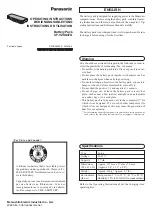
Installation Manual: Whipple SC 21_F150_R5
Last Updated: June 12
th
, 2021
Page 38 of 39
www.whipplesuperchargers.com
117.
After the initial test drive, go through the belt tensioner process again. When next you start driving, gradually work
the vehicle to wide open throttle runs. Listen for any engine detonation (pinging). If engine detonation is present,
let up on the throttle immediately. Most detonation causes are low octane gasoline still in the tank. The F150 uses
factory wide band O2 sensors, which means it will control air fuel ratio to the target. Fuel trims will adapt for
variances. Fuel pressure is 70psi +/- 5psi and never should dip below the specified margin. Trucks with high mileage
may have clogged fuel filters or deteriorated fuel pumps. Any truck with 50,000 or more miles should verify fuel
pressure during testing.
118.
If you have questions about your vehicles performance, please
check with your installation facility or call Whipple
Superchargers at 559.442.1261, Monday through Friday from 8am to 5:00pm, pacific time or email questions to
WARNING
!!
Verify the bypass actuator is working properly. To monitor, look at the bypass arm when the motor
is not running. Start engine and verify that the actuator arm has opened. This arm will be extended when the engine is
above 1” of vacuum (boost) and will be open when there is more than 1” of engine vacuum.
There is a great deal of misinformation about the function of supercharger bypass systems. The supercharger is a positive-
displacement pump; that is, so long as it is rotating, it is always pumping air. During low demand or high vacuum operation
(i.e. idle, deceleration, and light throttle cruise), the pumping action is undesirable as it creates unwanted heat and noise.
The bypass circuit, when open, prevents any pressure buildup across the supercharger and allows air to circulate through
the rotors, allowing the supercharger to “idle” freely during these conditions. This results in reduced noise, and by reducing
heat buildup in the intake, significantly improves street and strip performance. As throttle demand increases, the bypass
circuit is closed, resulting in full performance and strip performance. As throttle demand increases, the bypass circuit is
closed, resulting in full performance from the supercharger. The bypass circuit is never used to limit or control boost during
full-throttle operation and defeating or altering the bypass function will not result in improved performance in any condition,
and will result in poor drivability and possible supercharger damage.
MAINTENANCE AND SERVICE
Be sure to follow the maintenance and service recommendations below to optimize the life and performance of your
Whipple-supercharged vehicle.
1.
Use only premium grade fuel (91-octane or higher). RON+MON/2. The PCM calibration will automatically detect higher
octane levels and will increase power accordingly.
2.
Always listen for any sign of spark knock or pinging. If present, discontinue use immediately and consult your vehicle
owner’s manual.
3.
Do not operate the vehicle at large throttle opening if the MIL lamp is on steadily. This indicates an electronic engine
control malfunction: reduce throttle opening to a safe location. Use the supplied flash tool to read the DTC and consult
with Whipple or your Whipple dealer.
4.
Check the supercharger oil level at every engine oil change. Add Whipple SC oil to the supercharger if required. Do not
overfill the supercharger rear gear case.
5.
Change the oil in the supercharger every 100,000 miles unless pulley is changed. Changing pulleys requires shorter
mileage intervals. Use Whipple SC oil or Ford #XL-4 only.
CAUTION!!
Severe damage to the compressor will occur if you overfill the supercharger rear gear case.
6.
Do not operate the vehicle at large throttle opening if the MIL lamp is on steadily. This indicates an electronic engine
control malfunction: reduce throttle opening and consult your vehicle dealer.
7.
Inspect and clean your high-flow air filter element every 7,500 miles.
8.
Inspect and replace spark plugs every 20,000 miles. Only run specified Denso plugs.
9.
Follow your factory service intervals for oil changes and other typical maintenance items.
10.
Check the supercharger/accessory drive belt. Adjust or replace as required.
CAUTION!!
Any modification to your vehicle’s new computer program may cause serious damage to the
engine and/or drive train. The PCM is locked to the VIN, never let anyone, including dealerships install
updates to the PCM. Modifications to the PCM will lock power to stock power levels.


































